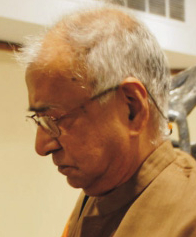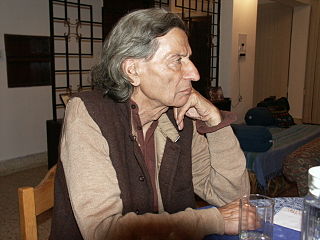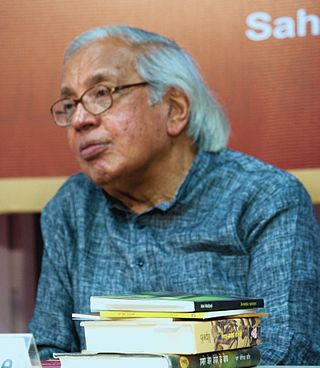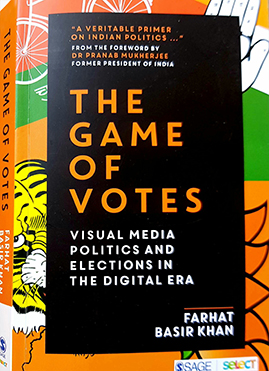
Ratan Parimoo, born in Kashmir, is an art historian, art educator, pedagogue, artist and former director of the Lalbhai Dalpatbhai Museum, Ahmedabad. Ratan Parimoo was one of the founder members of Baroda Group.

The Lalit Kala Akademi or National Academy of Art (LKA) is India's national academy of fine arts. It is an autonomous organisation, established in New Delhi in 1954 by Government of India to promote and propagate understanding of Indian art, in and outside the country.

Kerala Lalithakala Academy for Fine Arts is an autonomous body in Kerala state, India.
Sankho Chaudhuri was an Indian sculptor, and a noted figure in the art scene of India. (Although named Naranarain in due family tradition, he was more widely known by his pet name Sankho). Ram Kinker Baij was his teacher. He began close to cubism and then was influenced by István Beöthy, whom he had met in Paris. His themes have included the female figure and wildlife. He has worked in a wide range of media and produced large-scale reliefs and mobiles.

Kalpathi Ganpathi "K.G." Subramanyan was an Indian artist. He was awarded the Padma Vibhushan in 2012.

Pratiksha Apurv is an Indian painter, whose work is based on her uncle Bhagwan Shree Rajneesh (Osho)'s teachings. Before moving to painting, she was a successful fashion designer. Apurv won the National Award 2015-16 given by the Lalit Kala Akademi, Ministry of Culture for her painting 'Cosmic Balance', and has exhibited her artwork across the country. Her artwork has featured in books and magazines, and in 2018 she wrote and illustrated her own book, The Mystic and Her Colours.
A.J.K. Mass Communication Research Centre is a mass communication research centre located in New Delhi, India and a constituent institute of the Jamia Millia Islamia. The full form for AJK MCRC is Anwar Jamal Kidwai Mass Communication Research Centre named after its founder Anwar Jamal Kidwai in 1982.

Keshav Malik was an Indian poet, art and literary critic, arts scholar, and curator. He remained art critic for the Hindustan Times (1960–1972) and The Times of India (1975–2000). He published eighteen volumes of poetry and edited six anthologies of English translations of Indian poetry.
Bhabesh Chandra Sanyal commonly known as B. C. Sanyal, the doyen of modernism in Indian art, was an Indian painter and sculptor and an art teacher to three generations of artists. During his lifetime he not just saw the partition of the Indian subcontinent three times, 1905, 1947 and 1971, but also witnessed 20th century Indian art in all its phases. His notable paintings include The flying scarecrow, Cow herd, Despair and Way to peace, which depicts Mahatma Gandhi with a Hindu and a Muslim child.

Bhatkhande Sanskriti Vishwavidyalaya (BSV), formerly Bhatkhande Music Institute Deemed University (2000-2022), Bhatkhande College of Hindustani Music (1966-2000) and Marris College of Music (1926-1966), is a state university in Lucknow. Established in 1926 by Vishnu Narayan Bhatkhande, it was declared a deemed university by University Grants Commission (UGC) in 2000, and upgraded into a state university in 2022 by The Bhatkhande Sanskriti Vishwavidyalaya Act, 2022. It offers music education in Vocal Music, Instrumental, Rhythms, Dance, Musicology and Research and Applied Music.

V. Anamika is a Contemporary Artist born in Neelankarai, Chennai, Tamil Nadu, a student of S. Dhanapal, an eminent artist of India. She received her master's degree in Fine Arts in 1999 from Government College of Fine Arts, Chennai. She undertook a course on Care of museum objects at Government Museum in 2005. In 2006, she went to Scotland as a visiting artist scholar to learn Japanese wood-block printing at Edinburgh printmaker's studio.

Byomakesh Mohanty was an Indian artist and academic. After completing his science studies and graduating from Utkal University, Bhubaneswar, Orissa, he joined as a faculty of visual arts at Banaras Hindu University.

Ashok Vajpeyi is an Indian Hindi-language poet, essayist, literary-cultural critic, apart from being a noted cultural and arts administrator, and a former civil servant. He was chairman, Lalit Kala Akademi India's National Academy of Arts, Ministry of Culture, Govt of India, 2008–2011. He has published over 23 books of poetry, criticism and art, and was awarded the Sahitya Akademi Award given by Sahitya Akademi, India's National Academy of Letters, in 1994 for his poetry collection, Kahin Nahin Wahin. His notable poetry collections include, Shaher Ab Bhi Sambhavana Hai (1966), Tatpurush (1986), Bahuri Akela (1992), Ibarat Se Giri Matrayen, Ummeed ka Doosra Naam (2004) and Vivaksha (2006), besides this he has also published works on literary and art criticism: Filhal, Kuchh Poorvagrah, Samay se Bahar, Kavita ka Galp and Sidhiyan Shuru ho Gayi Hain. He is generally seen as part of the old Delhi-centric literary-cultural establishment consisting of bureaucrat-poets and academicians like Sitakanta Mahapatra, Keki Daruwalla, J.P.Das, Gopi Chand Narang, Indra Nath Choudhari and K.Satchidanandan.
Francis Kodankandath is an Indian contemporary artist. He won the 2003–2004 National Academy Award and the 1993 Kerala Lalit Kala Academy Award.He is son of Prof.K.P Antony and Mrs.Achamma Antony. He is a member of the Thandikkal Kodankandath family, Manaloor, Trichur, Kerala.
Avadhanam Sita Raman was an Indian writer and journalist and a former editor of the Illustrated Weekly of India. Born on 9 April 1919 at Proddatur in Kadapa district in the South Indian state of Andhra Pradesh, he secured his master's degree in economics from the Andhra University College of Arts and Commerce, Waltair. He started his career in 1936 as a writer and journalist with freelance contributions to English and Telugu publications such as Triveni, a literary and cultural quarterly. Later, in 1943, he joined the Hindustan Times in the capacity of a sub editor, moved on to publications such as The Statesman and The Times of India before joining the Illustrated Weekly of India in 1953, and rose to the rank of Editor, the first Indian editor of the weekly. He also worked as an art consultant to The Studio, an arts magazine published from London. At the end of the seventies, he joined Swarajya, a Madras-based weekly magazine.
Ranbir Singh Bisht (1928–1998) was an Indian painter and the Principal of the College of Fine Arts, Lucknow University. Born in 1928 at Landsdowne in Garhwal, in the present day Indian state of Uttarakhand, he secured Drawing Teacher's Training Certificate and Diploma in Fine Arts from the Government College of Art and Craft, Lucknow. He conducted many solo shows in a number of Indian cities besides a show in New York and participated in group shows in Frankfurt and Tokyo. He was also a participant of the 4th Triennale at New Delhi in 1972.
Mohammad Mujeeb (1902-1985) was an Indian writer of English and Urdu literature, educationist, scholar and the vice chancellor of Jamia Millia Islamia, Delhi.

Diwan Manna is an Indian conceptual artist and photographer. He completed his study in graphic art and printmaking from the Government College of Art, Chandigarh in 1982. He exhibited in India, United Kingdom, Germany, France, Poland, and Italy. From 2014 to 2015 he served as the director of Triennale India, organised by Lalit Kala Akademi, National Academy of Art, Ministry of Culture, Govt of India. He served as the chairman of Chandigarh Lalit Kala Akademi, State Academy of Art, Department of Culture, Chandigarh Administration. Currently, he is serving as the president of Punjab Lalit Kala Akademi, State Academy of Art, Ministry of Culture, Government of Punjab, India.

The Game of Votes: Visual Media Politics and Elections in the Digital Era is a 2019 non-fiction book by Farhat Basir Khan, an Indian photographer and a faculty member at the AJK Mass Communication and Research Centre, Jamia Millia Islamia.












